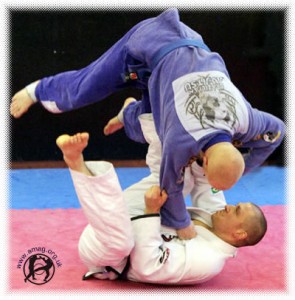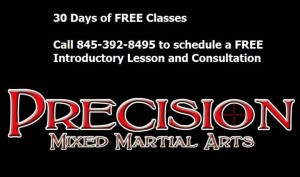
From its earliest origins in 17th century Japan to its 21st century application at Precision MMA in Poughkeepsie, New York, the martial art of “Jiu-Jitsu” has been a way for smaller opponents to overcome their larger adversaries. Translated from Japanese, “Jiu” literally means “gentle” and “Jitsu”, “art”. Akiyama Shirobei Yoshitoki created the first style of Jiu-Jitsu, “The Willow School”, over 400 years ago based on the ability of the branches of willow trees to withstand large amounts of snow fall by yielding to the pressure. Though this martial art adapted over the years and became the basis for Judo and later Brazilian Jiu-Jitsu, the focus would remain the same: teaching students to prevail in fights by utilizing the least amount of force.
In 20th century Brazil, Helio Gracie used these same principles to create the martial art of Brazilian Jiu-Jitsu. Growing up, Helio was a frail child. In fact, during most of his youth he was so weak due to illness that he could not even train and learned simply by watching his older brother Carlos in his lessons with Esae Maeda, the first Japanese foreigner to bring Jiu-Jitsu to Brazil. Later Helio’s physical weakness became Brazilian Jiu-Jitsu’s gain as he adapted the style to work for smaller and less athletic students. When his son Royce competed in the first Ultimate Fighting Championship in 1993, he too was smaller and weaker than most of his opponents, yet he overcame all of them by using superior technique and the principle of yielding. In fact, he defeated his first opponent in that tournament, the boxer Art Jimmerson, without landing one punch by simply taking him down and holding him in the mounted position until he became so frustrated he simply gave up and tapped out.
Precision Mixed Martial Arts in Poughkeepsie, New York boasts a direct lineage all the way back to Helio Gracie who himself can trace his Jiu-Jitsu lineage back to the founder of the Willow School. The gentle art has spanned four centuries and thousands of miles from Japan to Brazil to Poughkeepsie, New York. However, the goal of Jiu-Jitsu instructors at Precision remains the same today as it did in antiquity: for the teacher to impart the lesson of yielding to his student so that he can use minimal effort for maximum effect. A Jiu-Jitsu practitioner wants to defeat his opponent by using as little strength as possible, and also by doing as little damage as possible to his attacker. In fact, one of the greatest current Brazilian Jiu-Jitsu black belts and UFC fighters, Demian Maia, has been quoted as saying that he believes the best expression of his expertise in this martial art is to be able to win a fight without once striking his opponent.
Much like Maia, and similar to Royce Gracie in his first UFC fight, Precision Mixed Martial Arts in Poughkeepsie’s head instructor Brian McLaughlin won his first MMA fight without landing a single punch and without being hit once. In only twenty-two seconds, Brian tripped his opponent to the mat, established control, applied a choke and got him to submit. This is a perfect expression of the same martial art created centuries ago in Japan, and Brian imparts these same skills to his students during his martial arts classes in Poughkeepsie. One student at Precision who has learned the lesson of yielding as well as any is Brown Belt Karl Nemeth. Despite being only about 145lbs and smaller than most of his competition he is often able to use his technique to defeat much larger and stronger opponents in competition. The reason Karl is able to do this is because he grasps the concept of “yielding” that is so stressed in the martial art of Brazilian Jiu-Jitsu. When faced with a larger opponent, instead of trying to over power them or forcefully gain top position, he recognizes that his best course of action is to relax and use technique and flexibility to gain the upper hand. This is the essence of Jiu-Jitsu that the original “Willow School” was founded upon.
 However, the lesson of yielding stressed in martial arts like Jiu-Jitsu is not always an easy one to learn. When struggling with an adversary who wants to choke, strike or torque one’s limbs, it is a natural reaction to become tense, and to try to fight back using more strength than is necessary, or even useful. The lessons taught at Precision Mixed Martial Arts in Poughkeepsie teach proper body mechanics so students never waste their energy while grappling. Every movement is based on economy of motion: achieving the greatest result with the least amount of effort. For example, the famous Brazilian Jiu-Jitsu champion Marcello Garcia only weights 170lbs, but knows so much about proper body mechanics that he is able to make himself feel twice his weight while on top of an opponent without exerting extra energy. And while this concept is important in sport competition, it is absolutely essential for street self-defense. While one may be able to out muscle the opponent in a local Poughkeepsie tournament and get away with it, in the end they may leave themselves physically exhausted and depleted. Such exhaustion is excusable during sport competition, but can lead to disaster in a self-defense scenario where one’s ability to survive the altercation is dependent upon how much energy they can conserve. Martial artists must expect that if attacked in the street they may have an adrenaline dump that will leave them physically drained. They must expect that they will be up against bigger, stronger attackers, possibly multiple and possibly armed. Furthermore, they will probably not even know the attack is coming. With all the odds stacked in the attacker’s favor the last thing a martial artist wants is to be tense and to use too much strength giving the attacker an even greater advantage. The lessons taught in Jiu-Jitsu will allow the student to prepare for being overpowered, and this will in turn allow him to remain calm and use his superior technique to survive. The economy of motion taught in Jiu-Jitsu is based upon muscle memory: the student becomes so used to performing the same movements in a relaxed motion that when it comes time to put his skills to use, “muscling” his opponent is hardly even an option. In fact, it would require undoing what has already been learned. Because of this martial art’s focus on muscle memory and economy of motion, all reactions are natural and do not require actual “thought”. In the same way that the techniques taught in our Poughkeepsie Mixed Martial Arts classes do not require physical strength, neither do they require mental exertion. To quote the great Brazilian Jiu-Jitsu champion Saulo Ribiero, in Jiu-Jitsu “if you think, you’re late. If you’re late, you muscle. If you muscle, you get tired. If you’re tired, you die.”
However, the lesson of yielding stressed in martial arts like Jiu-Jitsu is not always an easy one to learn. When struggling with an adversary who wants to choke, strike or torque one’s limbs, it is a natural reaction to become tense, and to try to fight back using more strength than is necessary, or even useful. The lessons taught at Precision Mixed Martial Arts in Poughkeepsie teach proper body mechanics so students never waste their energy while grappling. Every movement is based on economy of motion: achieving the greatest result with the least amount of effort. For example, the famous Brazilian Jiu-Jitsu champion Marcello Garcia only weights 170lbs, but knows so much about proper body mechanics that he is able to make himself feel twice his weight while on top of an opponent without exerting extra energy. And while this concept is important in sport competition, it is absolutely essential for street self-defense. While one may be able to out muscle the opponent in a local Poughkeepsie tournament and get away with it, in the end they may leave themselves physically exhausted and depleted. Such exhaustion is excusable during sport competition, but can lead to disaster in a self-defense scenario where one’s ability to survive the altercation is dependent upon how much energy they can conserve. Martial artists must expect that if attacked in the street they may have an adrenaline dump that will leave them physically drained. They must expect that they will be up against bigger, stronger attackers, possibly multiple and possibly armed. Furthermore, they will probably not even know the attack is coming. With all the odds stacked in the attacker’s favor the last thing a martial artist wants is to be tense and to use too much strength giving the attacker an even greater advantage. The lessons taught in Jiu-Jitsu will allow the student to prepare for being overpowered, and this will in turn allow him to remain calm and use his superior technique to survive. The economy of motion taught in Jiu-Jitsu is based upon muscle memory: the student becomes so used to performing the same movements in a relaxed motion that when it comes time to put his skills to use, “muscling” his opponent is hardly even an option. In fact, it would require undoing what has already been learned. Because of this martial art’s focus on muscle memory and economy of motion, all reactions are natural and do not require actual “thought”. In the same way that the techniques taught in our Poughkeepsie Mixed Martial Arts classes do not require physical strength, neither do they require mental exertion. To quote the great Brazilian Jiu-Jitsu champion Saulo Ribiero, in Jiu-Jitsu “if you think, you’re late. If you’re late, you muscle. If you muscle, you get tired. If you’re tired, you die.”
Aside from physical “yielding”, Precision Mixed Martial Arts in Poughkeepsie, New York teaches the lesson of mental yielding as well. At Precision we do not train with egos. Beginning students often have a competitive mentality and do not want to submit while grappling, but they quickly learn that tapping is a part of regular training. In fact, if one trains regularly but is never submitted, it most likely means that they are not challenging themselves enough. In the long run, this lack of physical and mental challenge creates rigidity, and rigidity is the opposite of the “gentle way”. However, what is so great about the martial art of Jiu-Jitsu is that it can be trained at full speed without hurting one’s opponent. Two students can grapple at a high pace, and yet if one gets the other into a submission, it is easy to let go without causing harm. And while this principle is true of Brazilian Jiu-Jitsu as a whole, there are still schools whose teachers do not stress this enough. The practice of catch and release is emphasized at Precision Mixed Martial Arts in Poughkeepsie so that we can continue to train hard every day. And finally, Precision MMA in Poughkeepsie is a school where it’s students are encouraged to think outside of the box. If one technique is not working, another may. We like to think that our students do not stick to one style or routine and that if need be, they can be as flexible as a willow branch.
The essence of the martial art of Jiu-Jitsu has never changed: to overcome superior force through superior technique and flexibility of mind and body. Precision MMA in Poughkeepsie has not forgotten its roots in either ancient Japanese or 20th century Brazilian culture.
For more information on Poughkeepsie Martial Arts, visit our website: http://www.poughkeepsiemixedmartialarts.com
About the author
Jamey Bazes is a lifelong martial artist holding a brown belt in both Brazilian Jiu-Jitsu and Kenpo Karate. He also holds a master’s degree from SUNY New Paltz. He is a student of Precision Mixed Martial Arts in LaGrange, NY (near Poughkeepsie) and a decorated competitor including a Delaware Brazilian Jiu-Jitsu State Championship and a NAGA World Title. to train with Jamey in Poughkeepsie NY check out Precision MMA http://www.poughkeepsiemixedmartialarts.com